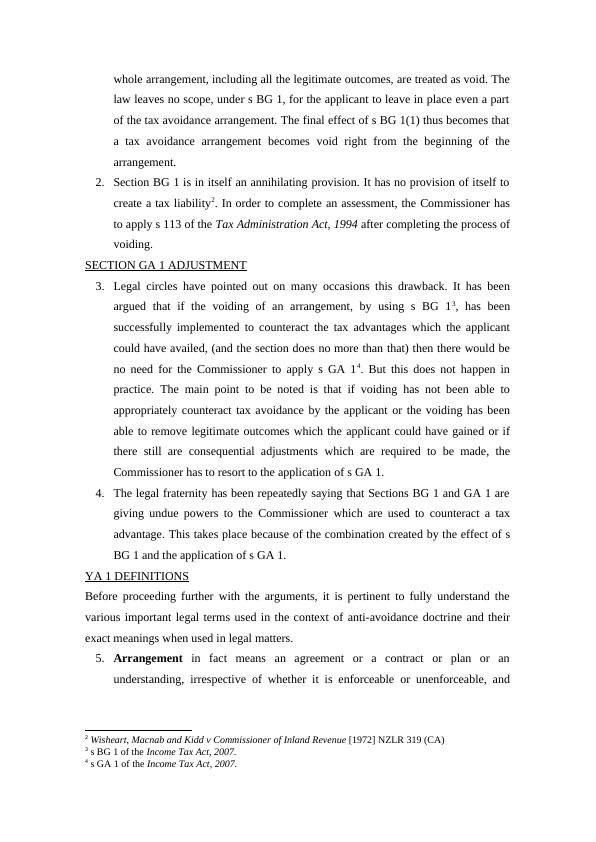New Zealand Taxation Paper
9 Pages3017 Words151 Views
Added on 2019-11-25
New Zealand Taxation Paper
Added on 2019-11-25
ShareRelated Documents
NZ TAXATION1.INTRODUCTIONA.BACKGROUNDSection BG 1 of the Income Tax Act, 2007 of New Zealand deals with the general anti-avoidance provisions explained in the Act. Whereas Section GA 1 of the cited Act givesthe Commissioner power to make adjustments after the application of s BG 1. Thesetwo legal provisions broadly outline the legal stand which the Commissioner can takeon tax avoidance in New Zealand. They also outline the approach which theCommissioners have been adopting towards implementing the Anti-avoidanceregulations in New Zealand.B.OBJECTIVESApplication of s BG 1 is usually considered only after determining if other provisionsunder the Act are applicable or not. To evaluate this arrangement, a specific provision isinterpreted in accordance to its purpose as defined under s 5(1) of the InterpretationAct, 1999. Hence, s BG 1 can only be considered as applicable in view of the wholearrangement after circumventing other specific provisions and discarding them.C.SCOPEInterpretation of these sections was set as a procedure by the New Zealand SupremeCourt in the case of Ben Nevis Forestry Ventures Ltd v Commissioner of InlandRevenue [2008] NZSC 115, [2009] 2 NZLR 289. Through this judgment, the SupremeCourt indicated its intention in settling the approach to be followed in establishing therelationship between s BG 1 and rest of the Income Tax Act, 20071.1Ben Nevis Forestry Ventures Ltd v Commissioner of Inland Revenue [2008] NZSC 115, [2009] 2 NZLR 289.

2.METHODA.ISSUEThe issue being considered in this paper is the general anti-avoidance provisionscontained in the Income Tax Act, 2007 under ss BG 1 and GA 1 and the relevant termsas defined in s YA 1 of the Act. There are still cases where matters on tax avoidance arereferred to the predecessors of ss BG 1 and GA 1, notably:s 108 of the Land and Income Tax Act, 1954;s 99 of the Income Tax Act, 1976;ss BG 1 and GB 1 of the Income Tax Act, 1994; and ss BG 1 and GB 1 of the Income Tax Act, 2004.B.LAWs BG 1 of the Income Tax Act, 2007.s GA 1 of the Income Tax Act, 2007.s YA 1 of the Income Tax Act, 2007.Elmiger v Commissioner of Inland Revenue [1966] NZLR 683 (SC) at 687–688.W T Ramsay Ltd v Inland Revenue Commissioners [1982] AC 300 (HL).Furniss (Inspector of Taxes) v Dawson [1984] AC 474 (HL).Challenge Corporation Ltd v Commissioner of Inland Revenue [1986] 2 NZLR 513 at 555(PC).Miller v Commissioner of Inland Revenue [1999] 1 NZLR 275 (CA).Commerce Commission v Fonterra Co-operative Group Ltd [2007] NZSC 36, [2007] 3NZLR 767.Ben Nevis Forestry Ventures Ltd v Commissioner of Inland Revenue [2008] NZSC 115,[2009] 2 NZLR 289.Penny v Commissioner of Inland Revenue [2011] NZSC 95, [2012] 1 NZLR 433.C.APPLICATIONSECTION BG 11.Section BG 1 has always been applied by the tax authorities for creating situationsto void the whole arrangement. This is because the language used in framing s BG1 does not allow any scope for apportionment, hence all tax outcomes of the

whole arrangement, including all the legitimate outcomes, are treated as void. Thelaw leaves no scope, under s BG 1, for the applicant to leave in place even a partof the tax avoidance arrangement. The final effect of s BG 1(1) thus becomes thata tax avoidance arrangement becomes void right from the beginning of thearrangement.2.Section BG 1 is in itself an annihilating provision. It has no provision of itself tocreate a tax liability2. In order to complete an assessment, the Commissioner hasto apply s 113 of the Tax Administration Act, 1994 after completing the process ofvoiding.SECTION GA 1 ADJUSTMENT3.Legal circles have pointed out on many occasions this drawback. It has beenargued that if the voiding of an arrangement, by using s BG 13, has beensuccessfully implemented to counteract the tax advantages which the applicantcould have availed, (and the section does no more than that) then there would beno need for the Commissioner to apply s GA 14. But this does not happen inpractice. The main point to be noted is that if voiding has not been able toappropriately counteract tax avoidance by the applicant or the voiding has beenable to remove legitimate outcomes which the applicant could have gained or ifthere still are consequential adjustments which are required to be made, theCommissioner has to resort to the application of s GA 1. 4.The legal fraternity has been repeatedly saying that Sections BG 1 and GA 1 aregiving undue powers to the Commissioner which are used to counteract a taxadvantage. This takes place because of the combination created by the effect of sBG 1 and the application of s GA 1.YA 1 DEFINITIONSBefore proceeding further with the arguments, it is pertinent to fully understand thevarious important legal terms used in the context of anti-avoidance doctrine and theirexact meanings when used in legal matters.5.Arrangement in fact means an agreement or a contract or plan or anunderstanding, irrespective of whether it is enforceable or unenforceable, and2Wisheart, Macnab and Kidd v Commissioner of Inland Revenue [1972] NZLR 319 (CA)3 s BG 1 of the Income Tax Act, 2007.4 s GA 1 of the Income Tax Act, 2007.

End of preview
Want to access all the pages? Upload your documents or become a member.
Related Documents
New Zealand Tax: Tax Benefits vs Tax Avoidancelg...
|13
|4584
|425
Tax Avoidance and Tax Planning: Understanding the Thin Linelg...
|11
|3599
|59
(PDF) Complexity of Tax Simplificationlg...
|5
|889
|23
Tax Avoidance and Tax Planning: Understanding the Differencelg...
|13
|3657
|74
Taxationlg...
|12
|3461
|32
Commissioner of Inland Revenue V Banks [1978] 2 NZLR 472 (CA)lg...
|4
|554
|41
